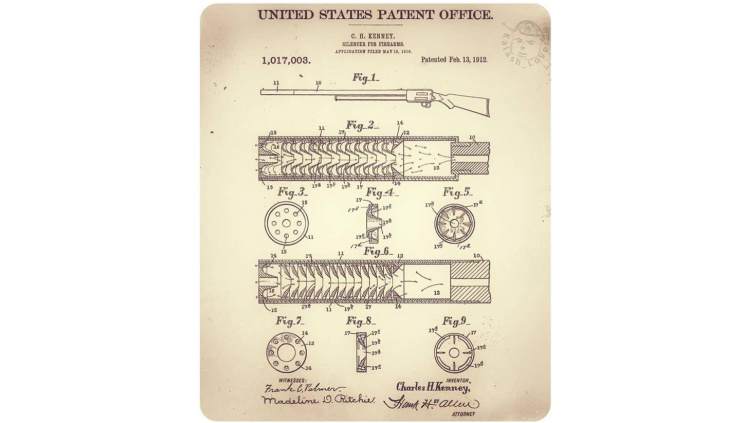Suppressors seem to be seen by many gun owners as cool but unnecessary. Maybe suppressors are considered accessories relegated to the realm of video games; perhaps they’re meant for Hollywood and the occasional popular social media personality. One thing is certain: the need and use of suppressors isn’t necessarily understood on a widespread level, and that’s where we come in. Consider this your primer to all things suppressor and why you should have at least one in your firearms collection.

Suppressor History
Sometimes it helps to have some insight into the history of things (that or I simply love history on a Gun Geek level, which is entirely possible).
Suppressors got their start on a commercial level back in the early 1900s. Back then they were known as silencers. It was Hiram Percy Maxim who got them going in the public market; Maxim was the son of Sir Hiram Maxim whom you might be familiar with as the guy who designed the Maxim machine gun which was the first full-auto of its kind. That’s a story for another day, though.

The younger Hiram Maxim wanted to find a way to shoot guns without making such a ruckus that it disturbed the neighbors.
In a quote attributed to him, he supposedly stated, “It occurred to me one day that there was no need for the noise…why not do away with it and shoot quietly?”
He founded the Maxim Silent Firearms Company, which ended up becoming the Maxim Silencer Company, in 1908 and wasted no time getting his product on the market. By 1909 they were selling for five dollars apiece at hardware stores, a concept hard for us to grasp in this day and age of NFA restrictions, tax stamps, and enormously pricey gear.
How did Maxim come up with the idea of how to bring his silencing idea to fruition?
Perusing his memoirs you can find some of his attempted methods prior to having success including a variety of by-passes, vents, and valves.
In Electrical Record, Volume 13, Maxim’s inspiration is explained with the following quote from the grandaddy of all things suppressed: “One morning after my bath I noticed in the bathtub the miniature whirlpool that forms over the drain hole when the plug is pulled and the water starts to run out. There was a familiar little hole down in the center of the whirl, and it started me thinking that here was an exactly similar case to my powder gas and bullet problems. Here was water in a bathtub, the drain plug pulled out, and yet the water was able to run out….but slowly because it was whirling. Why should not the powder gases act the same way as the water, if they were whirled? The whirling would give them centrifugal action precisely as it did the water and cause a hole to form in the center just as the hole formed in the water. In a flash I saw the ‘hole’ for which I had been looking for nearly two years.”

Probably due to Maxim’s desire to not bother his neighbors, early ad campaigns showed people cheerfully wielding his silencers – suppressors, whatever – in the yards outside their homes. There was even an ad depicting people using them inside their home, an activity with some foggy details. Maybe June Cleaver was an early John Wick, who knows?

On March 30, 1909, Maxim’s Patent Number 916885 was approved and suppressors were officially born.
How Does a Suppressor Work?
There are a lot of suppressors available today and the designs do vary. Let’s consider how Maxim’s design works.
Maxim’s suppressors are expansion-style systems meaning when you fire a shot all the super-heated gases produced spend some time traveling around the device’s internal chambers, giving them time to cool off and dissipate a bit more slowly. When the sounds of the shot being fired exits the chambers in what is really the blink of an eye, it’s muted compared to how it would be on an un-suppressed gun.
Back in 1909 when the US Ordnance tested the first successful Maxim suppressor they reported it reduced sound by 66 percent. You can see how that kind of noise suppression might be a very good thing.

Thanks to a couple of issues with that first official suppressor—things like the fact you couldn’t clean it and it obstructed your vision while shooting—Maxim went back to the drawing board. This is how we ended up with his 1910 model that featured angled holes throughout the tube for even greater noise reduction and a shift of the body of the suppressor so it no longer blocked the shooter’s vision.
You still couldn’t take that one apart, though. Today we have suppressors that can easily be disassembled and put back together, no MIT degree needed.

Modern Suppressor Design
Jump to modern times and we have two general types of suppressors: baffle stack and monocore. Those two classifications can be further broken down into user-serviceable and sealed designs, the former being models users can take apart themselves.
There are five kinds of sealed designs including fully welded stack, fully welded without a tube, tack-welded, cap-welded, and monocore. This is definitely not the place to get into the in-depth details of every system out there.
These suppressors all have partitions that create chambers which in turn dissipate the aforementioned gases and heat to make shots fired quite a bit quieter. Baffle stack suppressors have a number of conical – well, baffles – stacked inside them to create those chambers while monocore models are machined from the metal in one piece thanks to the miracle of CNC machines. Just how quiet they are depends on the specific suppressor and ammunition used.
A Word on Terminology
It’s accurate to refer to suppressors as suppressors, silencers, cans, you name it. There’s more debate on that particular topic than is necessary.
Originally they were silencers and now they’re called suppressors to signify the fact they only suppress, they do not silence guns. Don’t get wrapped up in tiny details like whether or not your friend Frank should be calling it a silencer, suppressor, or can.
Why Do You Need a Suppressor?
The use of suppressors isn’t just for the military or for Hollywood-esque assassins. In fact, the idea that they should be the purview of soldiers or guys sneaking through the shadows dressed in black is a problem.

The reality is suppressors are extremely useful for the average gun owner.
Has your hearing been damaged yet by your shooting habits? Probably—mine has been, despite obsessing over wearing ear protection. Ear pro can do only so much to reduce sound and it only meets the promises of reduction listed on the packaging when it’s used properly AND fits your ear canal just right. Good luck with that.
Suppressors are handy for everyone from hunters to the self-defense focused shooter to competition shooters.
Even if you’re doing some unsuppressed, ear-pro-necessary shooting at the range or at some venue for a match, doing a significant portion of your shooting suppressed is a brilliant plan. It’s simply good for your hearing.
After all, once you damage your hearing, it’s over. You’re not getting it back on a biological level, you’ll end up needing the intervention of doctors and electronic devices (says the gun writer sitting here with shooting-related tinnitus filling the silence).
They help with hunting, too.
When you’re hunting, suppressors are excellent because they not only protect your ears but enable you to more clearly hear what’s going on around you because you’re not wearing ear pro.
Yes, I realize a lot of hunters don’t bother with ear pro, but we should all be concerned with protecting our hearing.
You won’t hear that trophy buck coming if you’re going deaf from unprotecting shooting, now will you?
Suppressors also rock because you can take shots at, say, a sounder of hogs or even a field full of deer and buy yourself some time before your prey figures out what’s going on. That means more meat in your freezer.

Use a suppressor for self-defense training.
On the self-defense side, we tend to be high-round-count shooters (or should be). Self-defense shooting is a perishable skill and if you don’t keep it up, you lose it.

Doing a lot of that training suppressed is good for saving your ability to listen to your surroundings and remain alert to potential threats.
It is true to say you should spend time training unsuppressed wearing ear pro in order to have training time in running your gun without the added bulk of a suppressor at the muzzle. But there is no harm, only good, in trying to do most of your shooting with a can screwed onto the gun.
Bottom line? Get a suppressor.
It’s well worth the investment and protects not only your ears but the hearing of those around you, like your kids.
Suppressors add a layer of protection and safety to shooting and the importance of those things should not be minimized. Our hearing matters and should be protected.

How to get a suppressor?
Getting your gun hands on a suppressor costs more than it used to and it involves a process.
Thanks to the National Firearms Act of 1934 and the inclusion of suppressors as federally regulated items you have to jump through hoops and throw money at the government for the honor of owning a suppressor.
Basically, you buy your suppressor and leave it in gun jail. To free it from gun jail you have to fill out a Form 4, pay the two hundred dollar tax stamp, and wait to get approved by the ATF. This process also involves fingerprints, your local CLEO – Chief Law Enforcement Officer, and a passport-like photo.
Then you get to wait – and wait, and wait. How long the wait is to get Form 4 approved—if it’s approved—varies based on a lot of details, but I can promise you this, it won’t be fast. We’re not talking days or weeks, it’s months. Many months.
There’s more to the process, but you get the idea. You’re going to have to do paperwork, get FBI-quality fingerprints, have an attractive photo taken, and shell out some serious cash to get a suppressor. Despite all those things they remain well worth it.
Wouldn’t it be Nice…
It would be fantastic if suppressors were no longer regulated by the government. It’s been tried, of course, with things like the Hearing Protection Act which died before it could get through Congress. The odds of something like the HPA passing are slim to none, so don’t hold your breath.
Oh, and don’t decide, “I do what I want” and go the illegal suppressor route. Not only does the ATF keep tabs on items such as solvent traps but they will absolutely prosecute you.
It might stick in your craw, but follow the law when acquiring your suppressor. Maybe someday we can get suppressors deregulated—and it’s something smart to support and fight for—but today is not that day.
Play by the rules. Be patient and shoot suppressed to save your hearing. 10/10 recommended.



Pingback: KelTec Releases the P50 in 5.7mm - The Mag Life()
Pingback: Weekend Knowledge Dump- January 22, 2021 | Active Response Training()